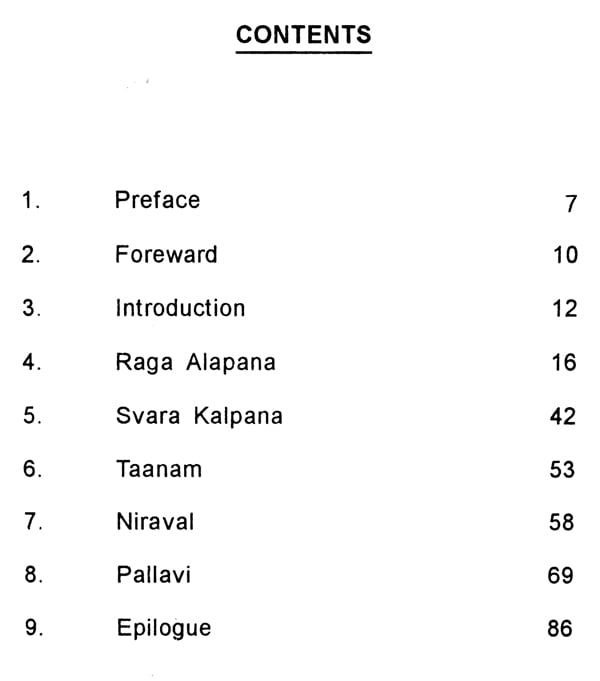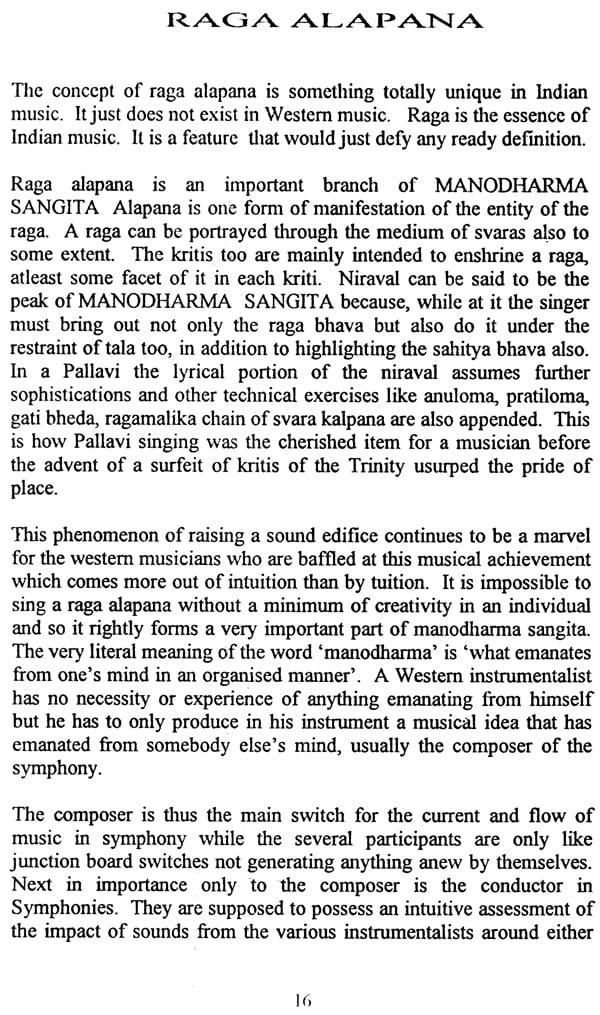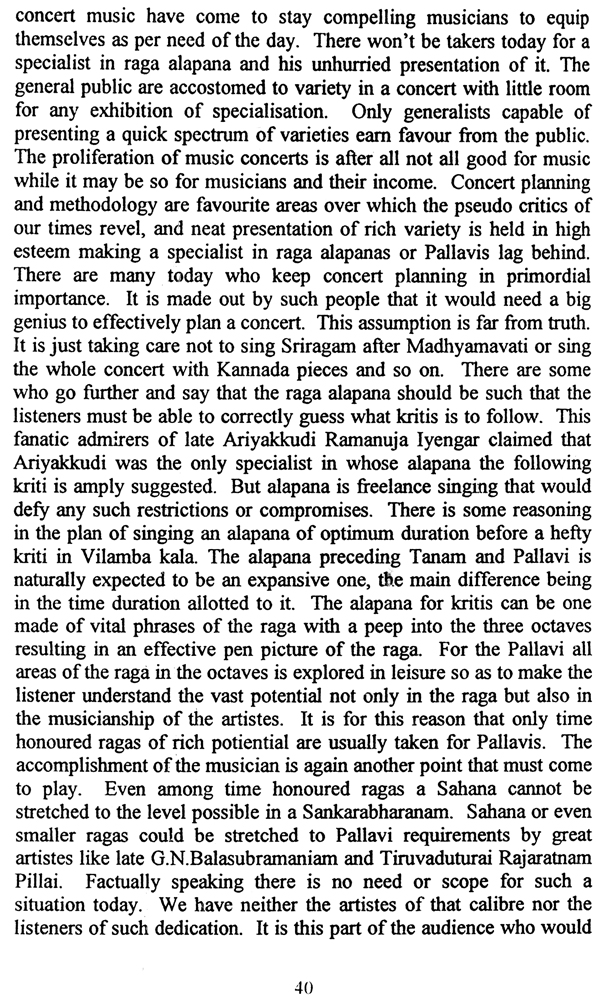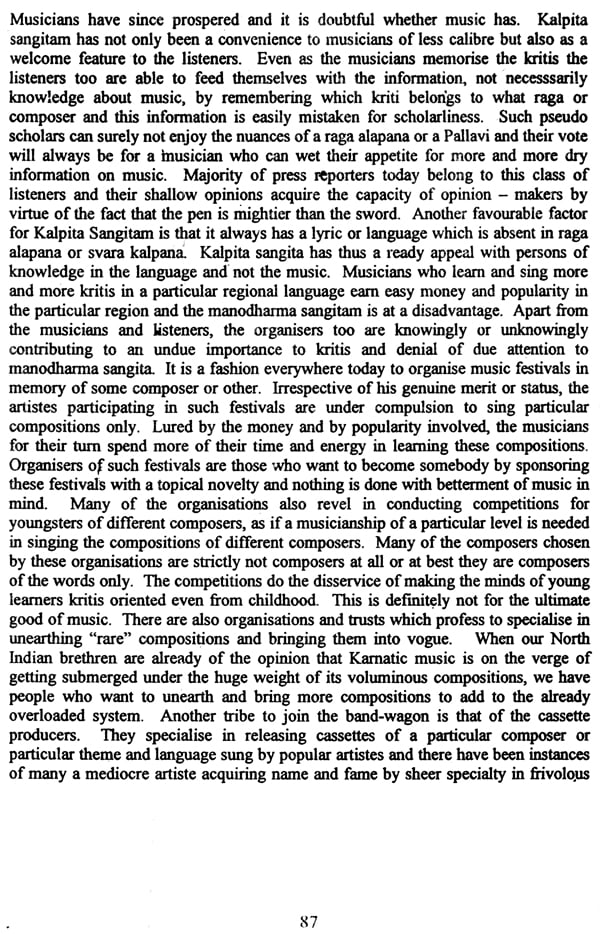
A Rational Approach to Manodharma Sangitam
Book Specification
| Item Code: | NAZ499 |
| Author: | Radha Venkatachalam |
| Publisher: | Music Education Trust, Delhi |
| Language: | English |
| Edition: | 2001 |
| Pages: | 88 |
| Cover: | PAPERBACK |
| Other Details | 8.50 X 5.50 inch |
| Weight | 120 gm |
Book Description
But total elimination of the intellectual approach is also not for the good of any human activity. A via media path of a happy fusion of intuition and tuition should be advisable "and this is exactly is what is intended in the application of the word 'Rational' in this book.
Environment is indeed favorable today for such a book mainly because of the fact that, unlike their predecessors, majority of our musicians today are richly educated and the exposure they get is much more than a gurukulite could have ever had. The gurukula system has vanished today mainly because of its inability to cope with the demands of modern human life. This book is therefore not intended for a gurukulite who has traditionally never been encouraged to seek knowledge from more than one source. Dealing with the subject of Pallavis in this book is therefore likely to sound outlandish and non-conforming to contemporary thoughts. Pallavi has been an unduly over mystified subject and the fearless and adventurous approach strongly based on mathematical reasoning proposed in this book may meet with disapproval among the so called traditionalists who usually encourage meek and dumb submission to what their guru said. The strength in the observations in this book lies in the fact that I am a PhD Scholar with a difference - not a dry musicologist but a performing artiste of considerable standing. Impeccable guidance derived from consultations with giants like Sri T.R. Subramanian, Sri Lalgudi Jayaraman, Sri R.K. Srikantan, Late Sri S. Kalyanaraman and the likes of them is a great source of strength in the conclusions arrived at in this book.
Having been 'a teacher in the Gandharva Maha Vidyalaya and Faculty of Music and Fine Arts, Delhi University for a nearly three decades now has also helped me in spotting the nuances that usually go unnoticed while communicating with students of various levels. This book does not purport to be a pedantic theory book on music. I have strived best to interact with the readers, at least those initiated into the subject in a manner by which they would be able to know where they stand in the ladder of learning and seek for the appropriate level of coaching. I have had quite a lot to tell the teachers too. There is no dearth of talent among learners today but the right teachers are not easily to be seen. If this book could stimulate thought in one good teacher its purpose can be considered achieved.
Guidelines are required to achieve that balance, concurrently optimizing aesthetic satisfaction and excellence. Without penchant for diversity, the emphasis, until the recent past has been highly individualistic, culminating in general disagreement and avoidable confusion. It is in this background, that the publication of this treatise by Dr. Radha Venkatachalam is 'welcome.
The author should be complimented for her unambiguous observation that there is something called Lakshana, 'Which goes in tandem 'Ninth Lakshya. Recently, some egotistic performing artists have declared that there is no Lakshana or norms and that their renditions get antiquated as norms.
Many years back, a paper vices presented on Kalpita and Manodharma Sangeeta at the Music Academy and subsequently published in the Journal. Dr. Radha Venkatacholam's views, concur 'with the earlier expressed views, 'Which is heartening. She has steered clear, in a very diplomatic manner, of the issue of relative importance of Kalpita and Manodharma Signets. It is not an over exaggeration to state that with the exception of Ragam, Tanam and Pallavi, Manodharma Sangeeta is an edifice built on Kalpita Sangeeta.
Apropos Alapana, the author has deftly dealt with the subject. Nevertheless, she has, for her own reasons, avoided criticism of the current trend to accelerate in Alapana, the avarohana Karma. Her devaluation of some obsolete form~ of Tana is Justin d. She has provided many practical examples, with a rational base. The linkage between Niraval and Sahitya is commendable. However, the interface between the lay aspect and Pallavis has been given only limited consideration. The passages on Swara-prastharas and the practical approach are overcome. On the viola, the post perusal impression one gathers is a highly favorable one, perhaps indicative of the pioneering efforts of the author.
This effort is unique, laudable and commendable for perusal and practice by connoisseurs, cognoscenti and performers. As anticipated, some views are preordained and opinionated, which may not find universal acceptability. We aspire that an enlarged version of this publication will follow suit, in the foreseeable future.
South India is rich in that Sangitam also which is technically called as Kalpita Sangitam. Kalpita mean that the music has been conceived and created much before it is sung. Musicians are singing today the hundreds of compositions composed by Tyagaraja, Muthuswamy Dikshitar, Syama Sastry and other great composers about two centuries ago. The song and the music in it have already been composed long back and we today only render them in a fashion already established by the composer. In other words, the words and music in the compositions are the creations of the earlier composers and not those of the musicians singing or playing them now. But musicians indulge in, thing other than the Ka/pita Sangita too and that portion of music will come under the head Manodharma Sangita. It means that the singer or player is performing and exhibiting something out of his own creative imagination, not merely rendering or reciting some music created already by some composer.
The same Ka/pita Sangita would have been an effort of manodharma to the original composers who would have labored over conceiving and creating a set of original words and incorporatitig them into an appropriate edifice of music to arrive at a composition which could be sung by any number of people who are actually not the creators of the words and the music in them. This situation can be compared to the roles of the weaver and the wearer. A weaver takes pains to go through the tiring process of creating a wearable cloth or dress from a collection of raw materials and the end product is available to be worn as clothes by any number of people who will surely not know anything about the separate art of weaving and the labor thereof.
Having thus arrived at two distinctly different expression of music - the Kalpita and the Manodharma - we are now free to discuss the various levels of status in the two varieties. As already said, Kalpita Sangita is the art of rendering a piece of music created by an earlier person, the performer having no need or responsibility to create anything anew in presenting a song. There may be a tendency to view this presentation of Klaipeda Sangita as something inferior since the performer's contribution in creating the music is very little. But in actual practice seasoned musicians and knowledgeable listeners will know that rendering Kalpita Sangita is after all is not so easy and mechanical a job. One and the same song in the hands of two musicians of different seniorities is sure to produce different effects.
Talent and capacity is indeed needed in the seemingly easy job of singing a piece of music handed down readymade as it were because the singer must be able to correctly read the musical and the lyrical message intended by the composer. This is one reason why we have today glaring difference in the various versions of the same Tyagaraja's compositions from one school to another, all of them claiming authenticity. In contrast with this, the MANODHARMA SANGITA is one in which the individual approach, totally free from interference from any other person's effort is highly appreciated. Full play of an individual's own creativity may not be possible while singing a kriti or any other item of KALPITA SANGITA but it is given full vent in other areas like Raga alapana, Niraval, Kalpana Svara, Tanam and Pallavi, all of which are collectively called MANODHARMA SANGITA - It is a matter of pride that the concept of such a MANODHARMA SANGITA exists only in India while almost all of what is heard in Western music performance is only KALPITA SANGITA The Instrumentalists in a symphony are infact provided with a stand before them with detailed notation of the intentions of the composer. A western musician thus enjoys freedom from not only memorizing the already composed music but also from the load of remembering it. The case is nearly opposite in Karnatic music. A performing musician here has to learn hundred of compositions thoroughly and also remember the voluminous lyrics in. detail. Keeping a sheet before and referring to it is frowned upon by traditionalists. The load on the memory of a Karnatic musician is indeed the highest while it is very little for a Western musician. The Hundustani musician comes in between.
Book's Contents and Sample Pages










